power steering DODGE RAM 3500 DIESEL 2008 3.G Owners Manual
[x] Cancel search | Manufacturer: DODGE, Model Year: 2008, Model line: RAM 3500 DIESEL, Model: DODGE RAM 3500 DIESEL 2008 3.GPages: 527, PDF Size: 8.88 MB
Page 60 of 527
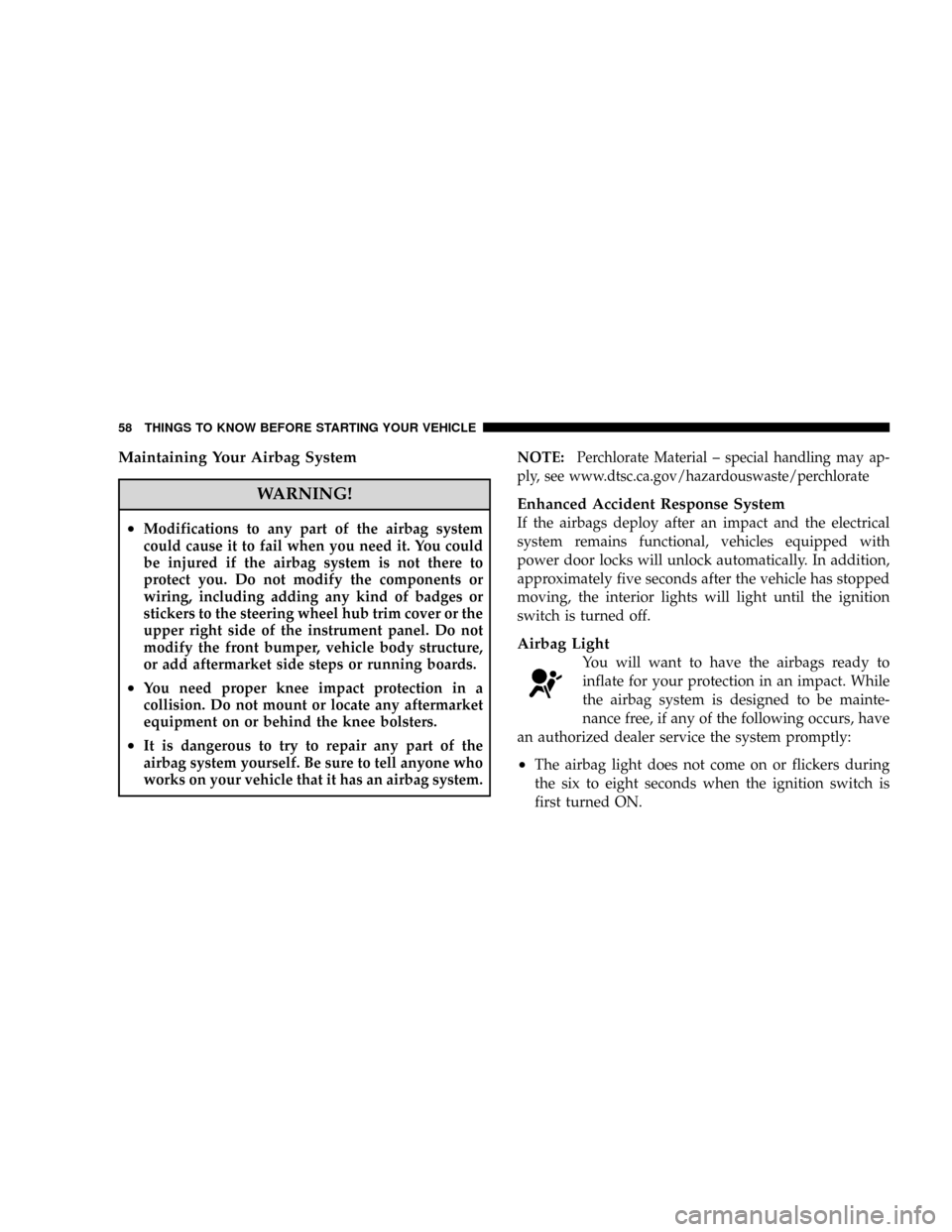
Maintaining Your Airbag System
WARNING!
²Modifications to any part of the airbag system
could cause it to fail when you need it. You could
be injured if the airbag system is not there to
protect you. Do not modify the components or
wiring, including adding any kind of badges or
stickers to the steering wheel hub trim cover or the
upper right side of the instrument panel. Do not
modify the front bumper, vehicle body structure,
or add aftermarket side steps or running boards.
²You need proper knee impact protection in a
collision. Do not mount or locate any aftermarket
equipment on or behind the knee bolsters.
²It is dangerous to try to repair any part of the
airbag system yourself. Be sure to tell anyone who
works on your vehicle that it has an airbag system.NOTE:
Perchlorate Material ± special handling may ap-
ply, see www.dtsc.ca.gov/hazardouswaste/perchlorate
Enhanced Accident Response System
If the airbags deploy after an impact and the electrical
system remains functional, vehicles equipped with
power door locks will unlock automatically. In addition,
approximately five seconds after the vehicle has stopped
moving, the interior lights will light until the ignition
switch is turned off.
Airbag Light
You will want to have the airbags ready to
inflate for your protection in an impact. While
the airbag system is designed to be mainte-
nance free, if any of the following occurs, have
an authorized dealer service the system promptly:
²The airbag light does not come on or flickers during
the six to eight seconds when the ignition switch is
first turned ON.
58 THINGS TO KNOW BEFORE STARTING YOUR VEHICLE
Page 82 of 527
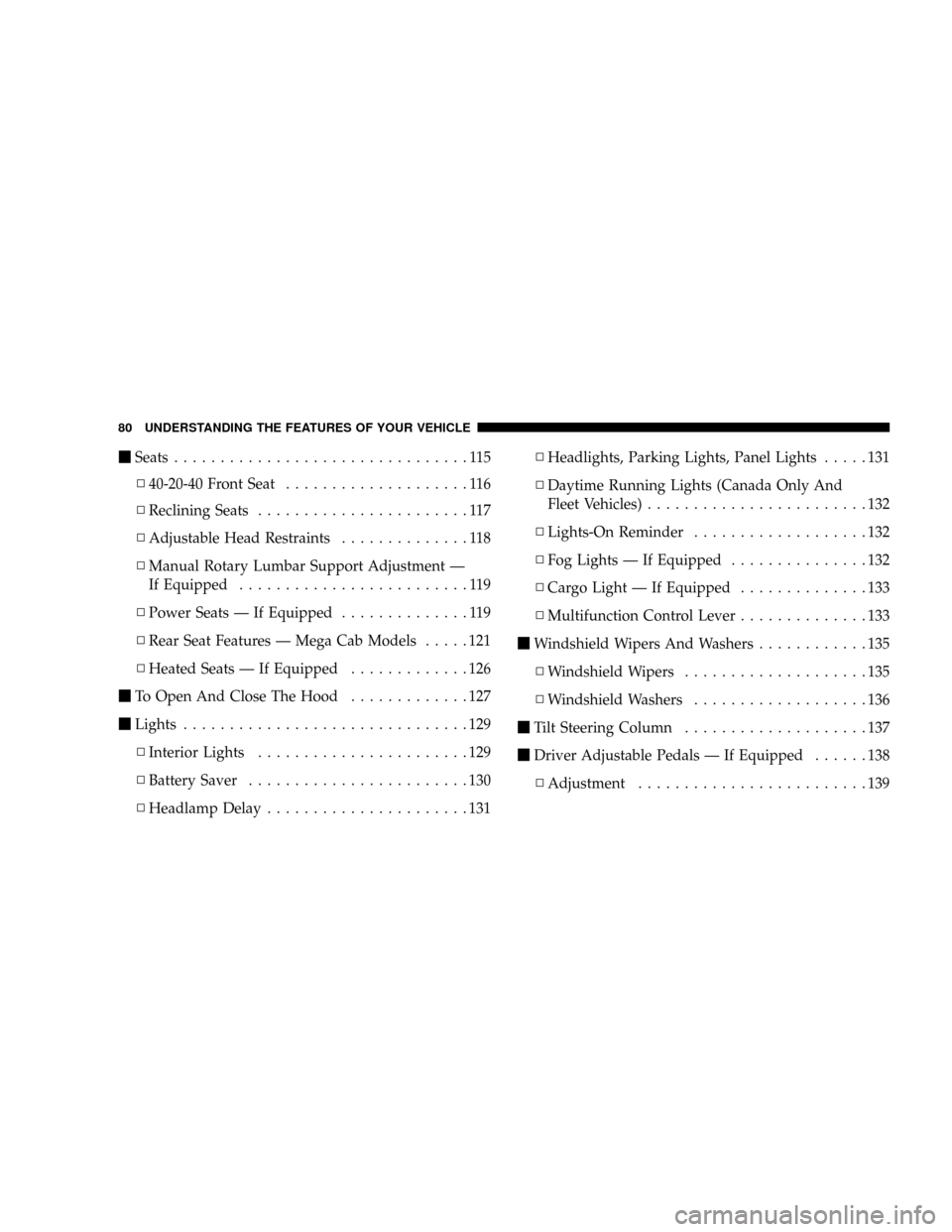
mSeats................................115
N40-20-40 Front Seat....................116
NReclining Seats.......................117
NAdjustable Head Restraints..............118
NManual Rotary Lumbar Support Adjustment Ð
If Equipped.........................119
NPower Seats Ð If Equipped..............119
NRear Seat Features Ð Mega Cab Models.....121
NHeated Seats Ð If Equipped.............126
mTo Open And Close The Hood.............127
mLights...............................129
NInterior Lights.......................129
NBattery Saver........................130
NHeadlamp Delay......................131NHeadlights, Parking Lights, Panel Lights.....131
NDaytime Running Lights (Canada Only And
Fleet Vehicles)........................132
NLights-On Reminder...................132
NFog Lights Ð If Equipped...............132
NCargo Light Ð If Equipped..............133
NMultifunction Control Lever..............133
mWindshield Wipers And Washers............135
NWindshield Wipers....................135
NWindshield Washers...................136
mTilt Steering Column....................137
mDriver Adjustable Pedals Ð If Equipped......138
NAdjustment.........................139
80 UNDERSTANDING THE FEATURES OF YOUR VEHICLE
Page 140 of 527
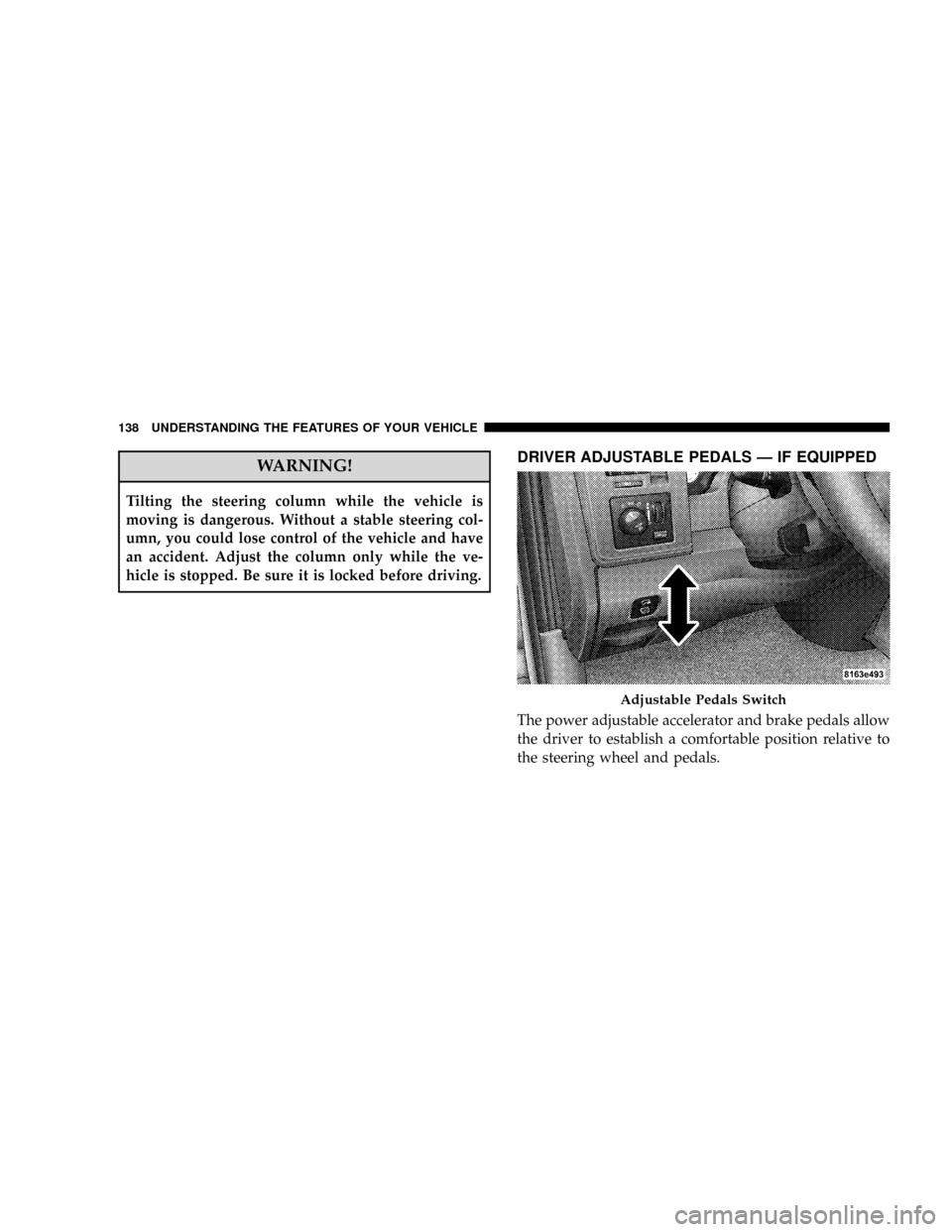
WARNING!
Tilting the steering column while the vehicle is
moving is dangerous. Without a stable steering col-
umn, you could lose control of the vehicle and have
an accident. Adjust the column only while the ve-
hicle is stopped. Be sure it is locked before driving.
DRIVER ADJUSTABLE PEDALS Ð IF EQUIPPED
The power adjustable accelerator and brake pedals allow
the driver to establish a comfortable position relative to
the steering wheel and pedals.
Adjustable Pedals Switch
138 UNDERSTANDING THE FEATURES OF YOUR VEHICLE
Page 203 of 527
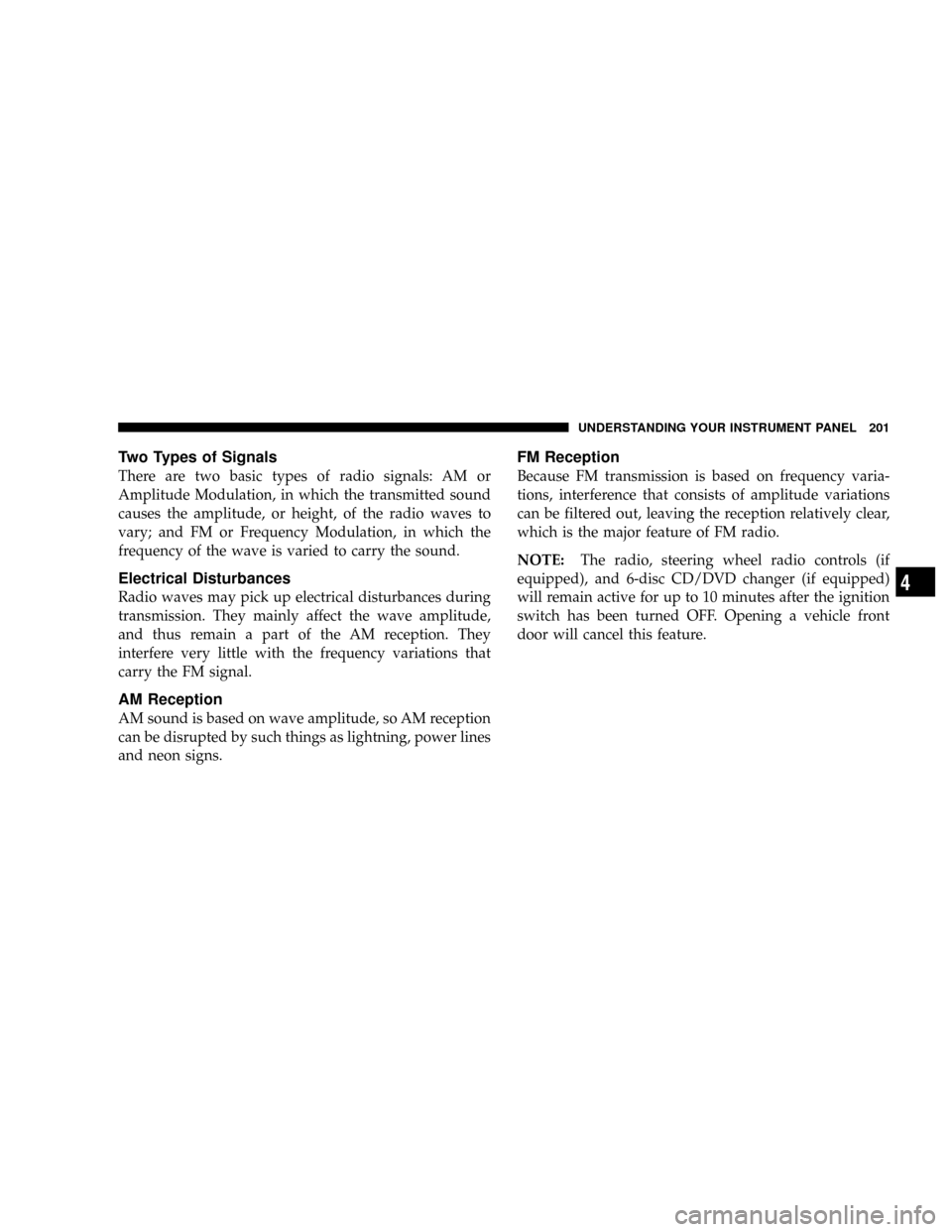
Two Types of Signals
There are two basic types of radio signals: AM or
Amplitude Modulation, in which the transmitted sound
causes the amplitude, or height, of the radio waves to
vary; and FM or Frequency Modulation, in which the
frequency of the wave is varied to carry the sound.
Electrical Disturbances
Radio waves may pick up electrical disturbances during
transmission. They mainly affect the wave amplitude,
and thus remain a part of the AM reception. They
interfere very little with the frequency variations that
carry the FM signal.
AM Reception
AM sound is based on wave amplitude, so AM reception
can be disrupted by such things as lightning, power lines
and neon signs.
FM Reception
Because FM transmission is based on frequency varia-
tions, interference that consists of amplitude variations
can be filtered out, leaving the reception relatively clear,
which is the major feature of FM radio.
NOTE:The radio, steering wheel radio controls (if
equipped), and 6-disc CD/DVD changer (if equipped)
will remain active for up to 10 minutes after the ignition
switch has been turned OFF. Opening a vehicle front
door will cancel this feature.
UNDERSTANDING YOUR INSTRUMENT PANEL 201
4
Page 266 of 527
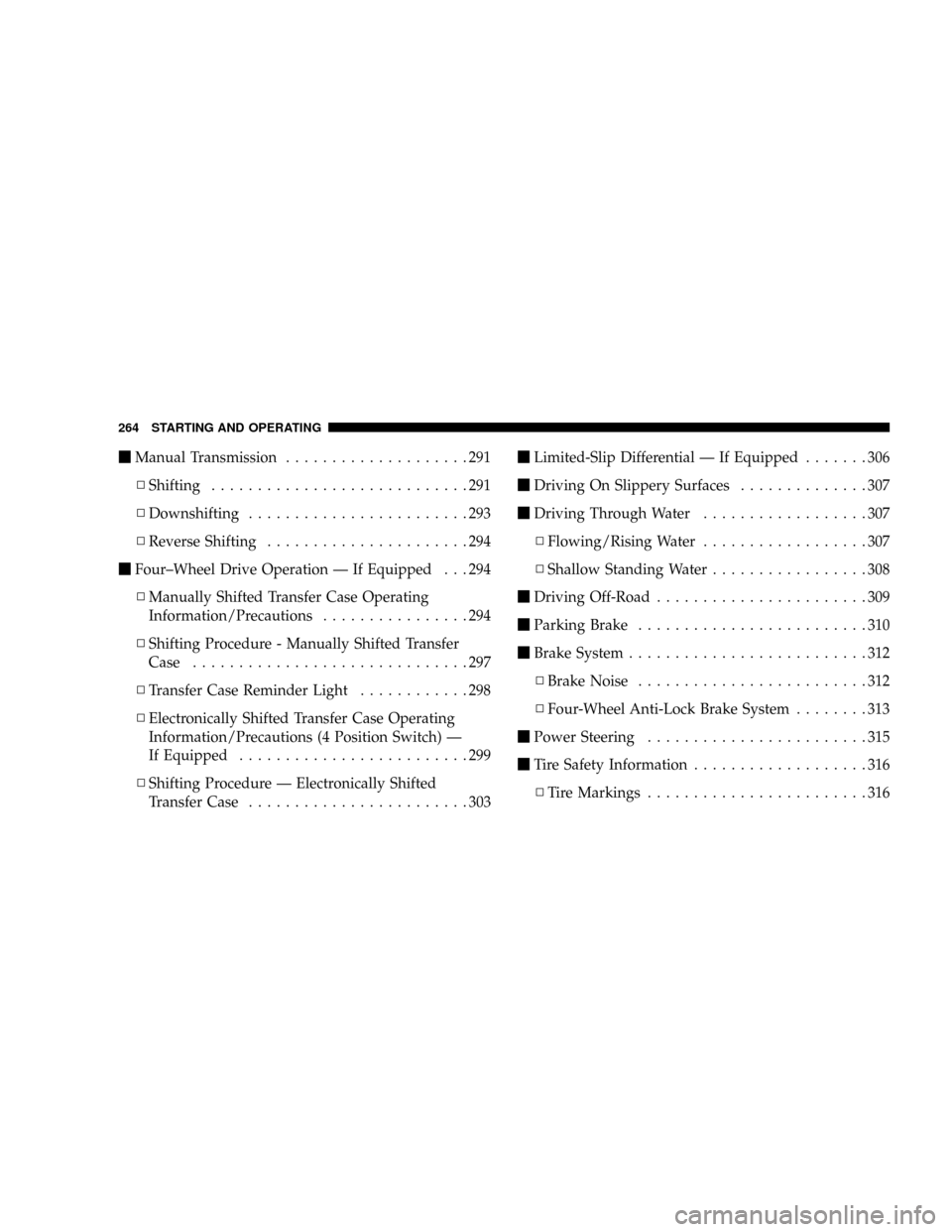
mManual Transmission....................291
NShifting............................291
NDownshifting........................293
NReverse Shifting......................294
mFour±Wheel Drive Operation Ð If Equipped . . . 294
NManually Shifted Transfer Case Operating
Information/Precautions................294
NShifting Procedure - Manually Shifted Transfer
Case..............................297
NTransfer Case Reminder Light............298
NElectronically Shifted Transfer Case Operating
Information/Precautions (4 Position Switch) Ð
If Equipped.........................299
NShifting Procedure Ð Electronically Shifted
Transfer Case........................303mLimited-Slip Differential Ð If Equipped.......306
mDriving On Slippery Surfaces..............307
mDriving Through Water..................307
NFlowing/Rising Water..................307
NShallow Standing Water.................308
mDriving Off-Road.......................309
mParking Brake.........................310
mBrake System..........................312
NBrake Noise.........................312
NFour-Wheel Anti-Lock Brake System........313
mPower Steering........................315
mTire Safety Information...................316
NTire Markings........................316
264 STARTING AND OPERATING
Page 317 of 527
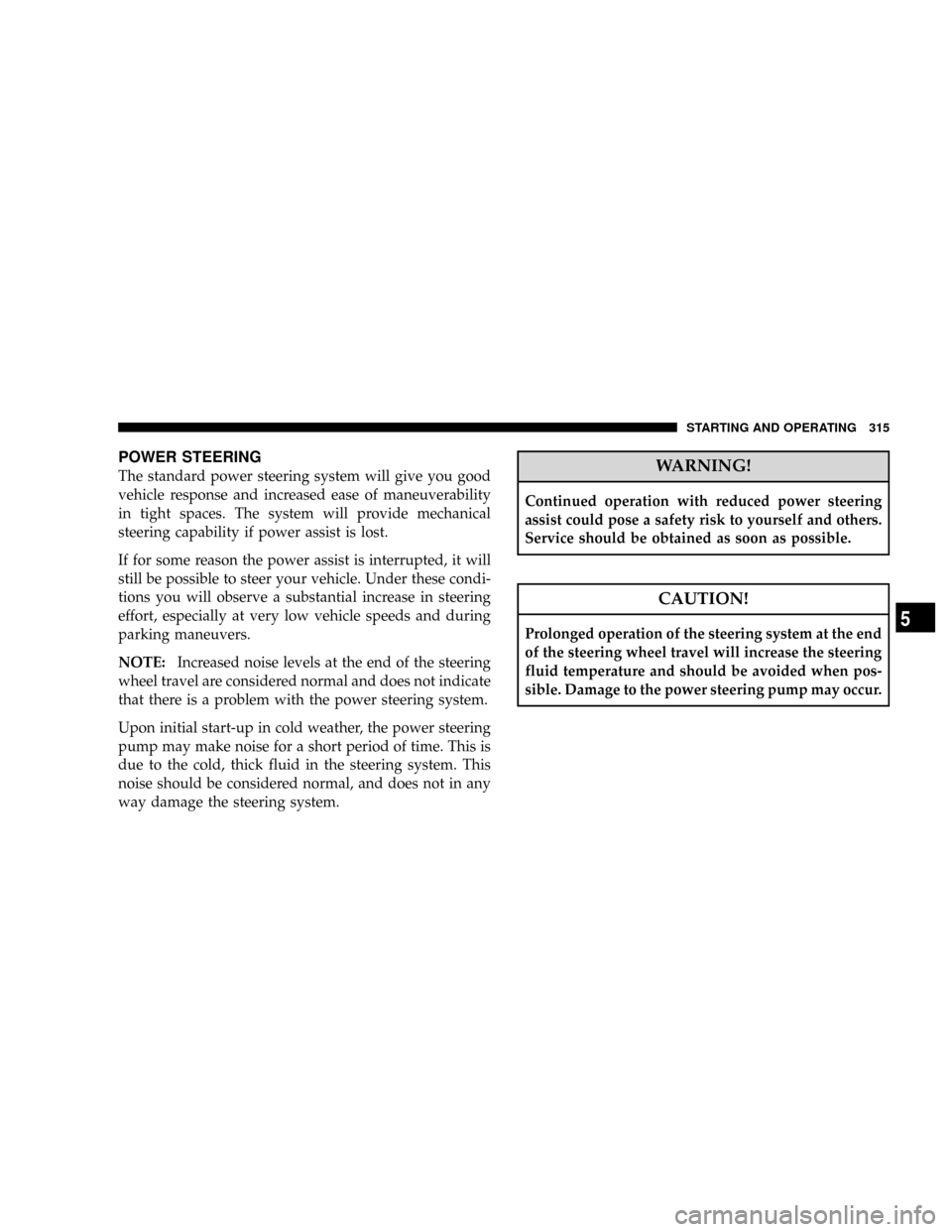
POWER STEERING
The standard power steering system will give you good
vehicle response and increased ease of maneuverability
in tight spaces. The system will provide mechanical
steering capability if power assist is lost.
If for some reason the power assist is interrupted, it will
still be possible to steer your vehicle. Under these condi-
tions you will observe a substantial increase in steering
effort, especially at very low vehicle speeds and during
parking maneuvers.
NOTE:Increased noise levels at the end of the steering
wheel travel are considered normal and does not indicate
that there is a problem with the power steering system.
Upon initial start-up in cold weather, the power steering
pump may make noise for a short period of time. This is
due to the cold, thick fluid in the steering system. This
noise should be considered normal, and does not in any
way damage the steering system.WARNING!
Continued operation with reduced power steering
assist could pose a safety risk to yourself and others.
Service should be obtained as soon as possible.
CAUTION!
Prolonged operation of the steering system at the end
of the steering wheel travel will increase the steering
fluid temperature and should be avoided when pos-
sible. Damage to the power steering pump may occur.
STARTING AND OPERATING 315
5
Page 407 of 527
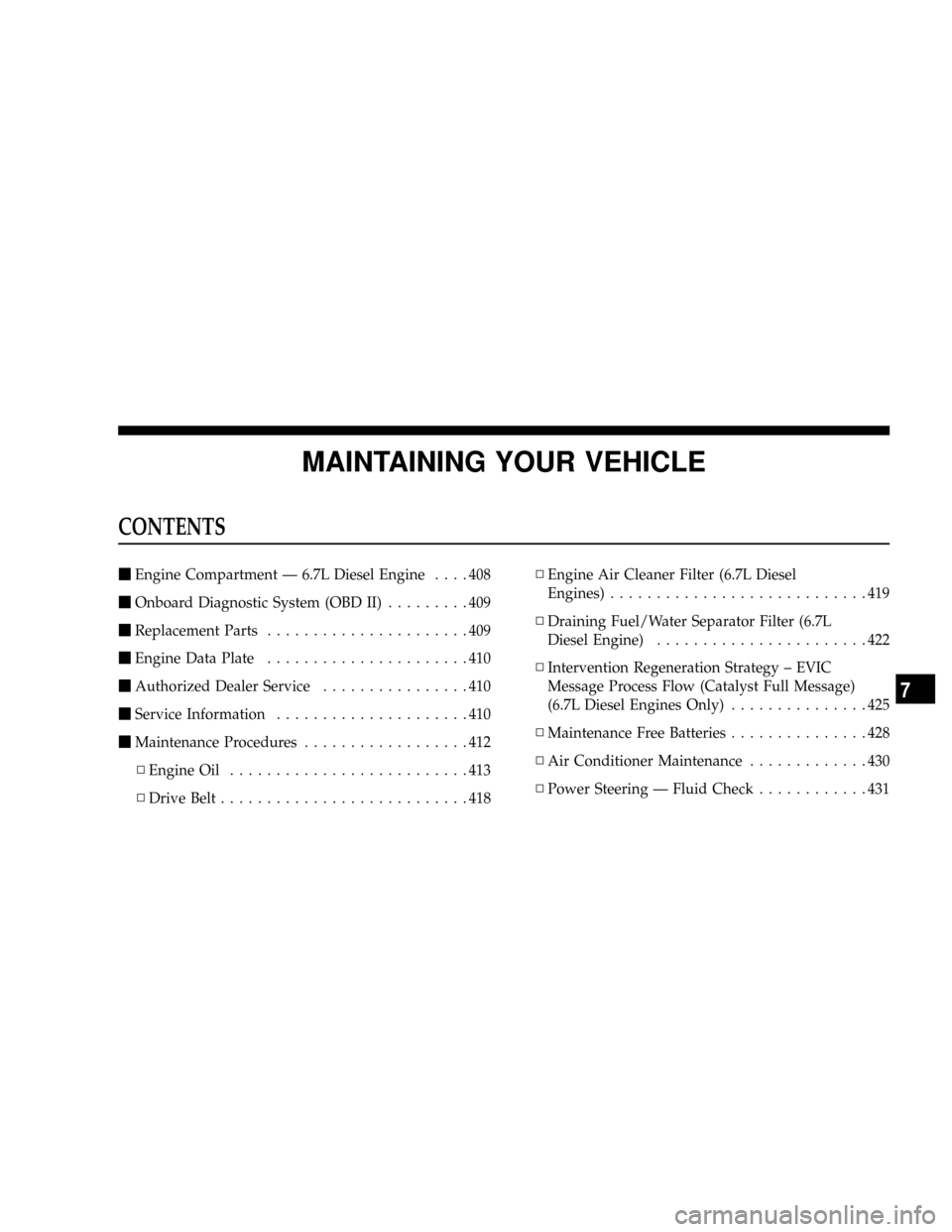
MAINTAINING YOUR VEHICLE
CONTENTS
mEngine Compartment Ð 6.7L Diesel Engine....408
mOnboard Diagnostic System (OBD II).........409
mReplacement Parts......................409
mEngine Data Plate......................410
mAuthorized Dealer Service................410
mService Information.....................410
mMaintenance Procedures..................412
NEngine Oil..........................413
NDrive Belt...........................418NEngine Air Cleaner Filter (6.7L Diesel
Engines)............................419
NDraining Fuel/Water Separator Filter (6.7L
Diesel Engine).......................422
NIntervention Regeneration Strategy ± EVIC
Message Process Flow (Catalyst Full Message)
(6.7L Diesel Engines Only)...............425
NMaintenance Free Batteries...............428
NAir Conditioner Maintenance.............430
NPower Steering Ð Fluid Check............431
7
Page 408 of 527
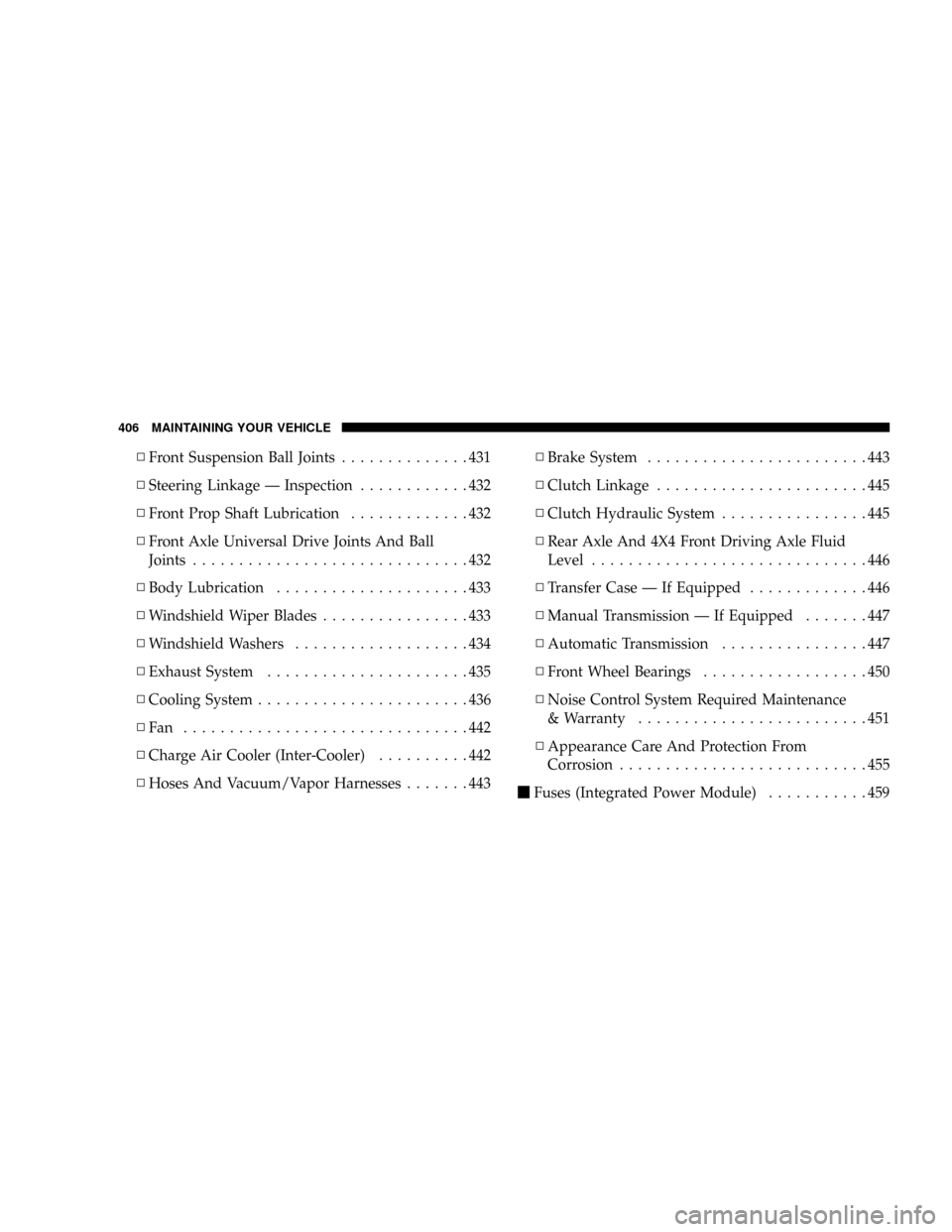
NFront Suspension Ball Joints..............431
NSteering Linkage Ð Inspection............432
NFront Prop Shaft Lubrication.............432
NFront Axle Universal Drive Joints And Ball
Joints..............................432
NBody Lubrication.....................433
NWindshield Wiper Blades................433
NWindshield Washers...................434
NExhaust System......................435
NCooling System.......................436
NFan ...............................442
NCharge Air Cooler (Inter-Cooler)..........442
NHoses And Vacuum/Vapor Harnesses.......443NBrake System........................443
NClutch Linkage.......................445
NClutch Hydraulic System................445
NRear Axle And 4X4 Front Driving Axle Fluid
Level..............................446
NTransfer Case Ð If Equipped.............446
NManual Transmission Ð If Equipped.......447
NAutomatic Transmission................447
NFront Wheel Bearings..................450
NNoise Control System Required Maintenance
& Warranty.........................451
NAppearance Care And Protection From
Corrosion...........................455
mFuses (Integrated Power Module)...........459
406 MAINTAINING YOUR VEHICLE
Page 433 of 527
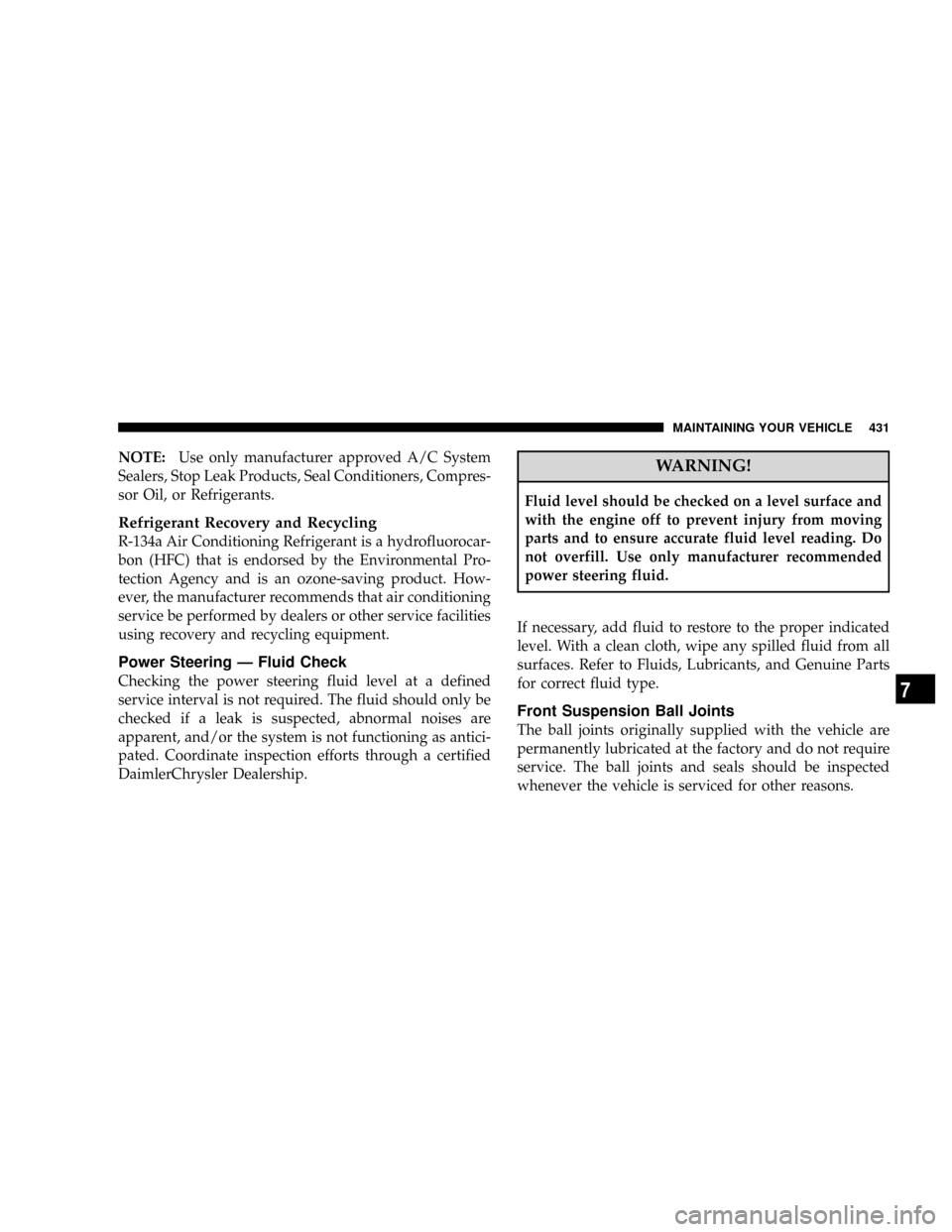
NOTE:Use only manufacturer approved A/C System
Sealers, Stop Leak Products, Seal Conditioners, Compres-
sor Oil, or Refrigerants.
Refrigerant Recovery and Recycling
R-134a Air Conditioning Refrigerant is a hydrofluorocar-
bon (HFC) that is endorsed by the Environmental Pro-
tection Agency and is an ozone-saving product. How-
ever, the manufacturer recommends that air conditioning
service be performed by dealers or other service facilities
using recovery and recycling equipment.
Power Steering Ð Fluid Check
Checking the power steering fluid level at a defined
service interval is not required. The fluid should only be
checked if a leak is suspected, abnormal noises are
apparent, and/or the system is not functioning as antici-
pated. Coordinate inspection efforts through a certified
DaimlerChrysler Dealership.
WARNING!
Fluid level should be checked on a level surface and
with the engine off to prevent injury from moving
parts and to ensure accurate fluid level reading. Do
not overfill. Use only manufacturer recommended
power steering fluid.
If necessary, add fluid to restore to the proper indicated
level. With a clean cloth, wipe any spilled fluid from all
surfaces. Refer to Fluids, Lubricants, and Genuine Parts
for correct fluid type.
Front Suspension Ball Joints
The ball joints originally supplied with the vehicle are
permanently lubricated at the factory and do not require
service. The ball joints and seals should be inspected
whenever the vehicle is serviced for other reasons.
MAINTAINING YOUR VEHICLE 431
7
Page 464 of 527
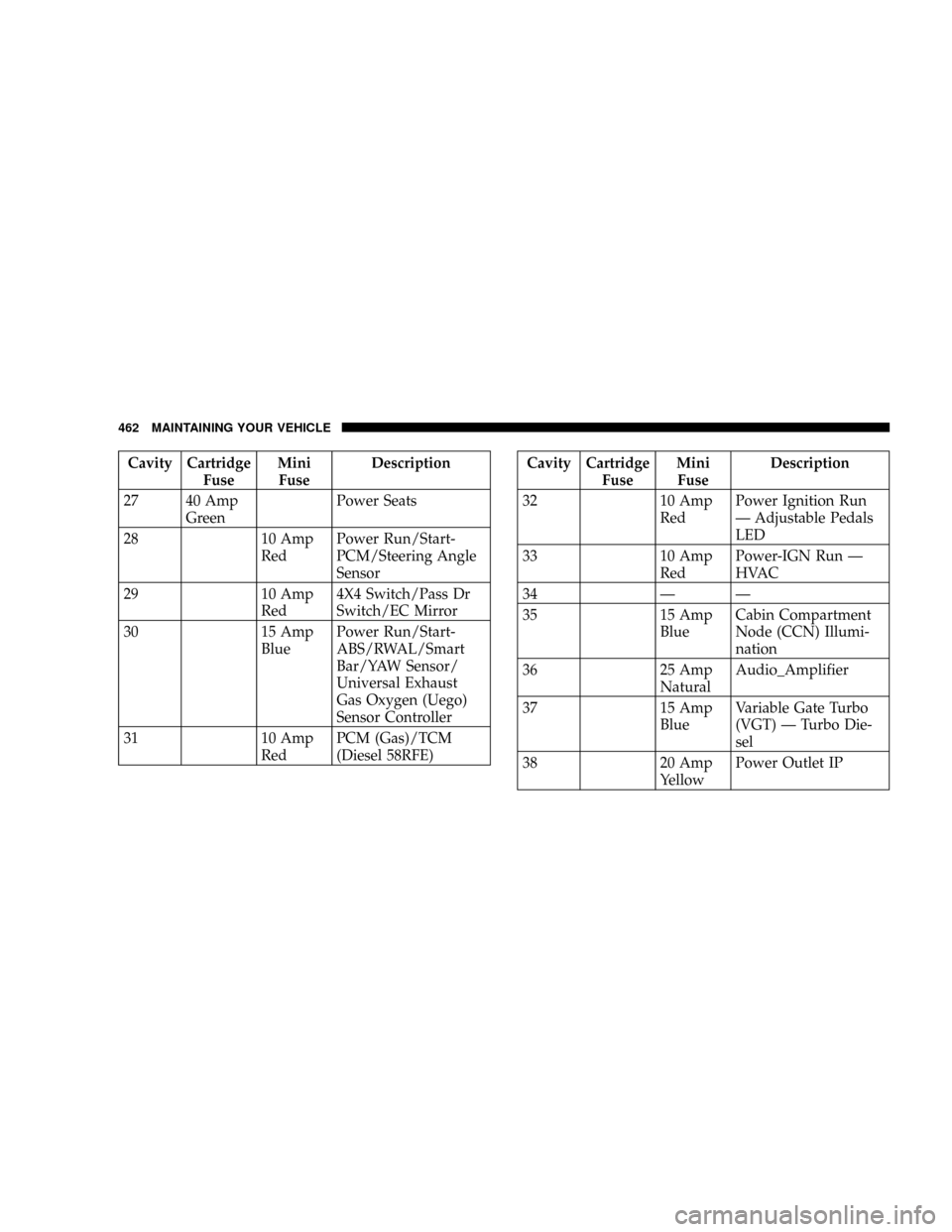
Cavity Cartridge
FuseMini
FuseDescription
27 40 Amp
GreenPower Seats
28 10 Amp
RedPower Run/Start-
PCM/Steering Angle
Sensor
29 10 Amp
Red4X4 Switch/Pass Dr
Switch/EC Mirror
30 15 Amp
BluePower Run/Start-
ABS/RWAL/Smart
Bar/YAW Sensor/
Universal Exhaust
Gas Oxygen (Uego)
Sensor Controller
31 10 Amp
RedPCM (Gas)/TCM
(Diesel 58RFE)Cavity Cartridge
FuseMini
FuseDescription
32 10 Amp
RedPower Ignition Run
Ð Adjustable Pedals
LED
33 10 Amp
RedPower-IGN Run Ð
HVAC
34 Ð Ð
35 15 Amp
BlueCabin Compartment
Node (CCN) Illumi-
nation
36 25 Amp
NaturalAudio_Amplifier
37 15 Amp
BlueVariable Gate Turbo
(VGT) Ð Turbo Die-
sel
38 20 Amp
YellowPower Outlet IP
462 MAINTAINING YOUR VEHICLE